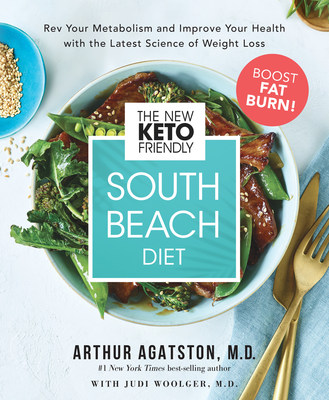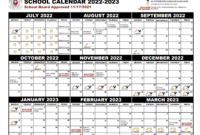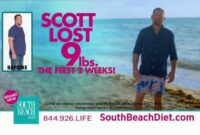South Beach Diet Book Online offers a convenient and accessible way to embark on this popular weight-loss journey. This comprehensive guide delves into the core principles of the South Beach Diet, outlining its phases, nutritional guidelines, and permitted and restricted foods. We’ll explore the various online platforms where you can purchase the book, comparing prices and discussing the advantages and disadvantages of digital access. We’ll also examine user reviews, comparing the South Beach Diet to other popular weight-loss plans and providing sample recipes.
This exploration covers everything from understanding the diet’s phases and nutritional recommendations to navigating online purchasing options and considering potential risks and long-term sustainability. We aim to provide a balanced perspective, incorporating both positive and negative user feedback to help you make an informed decision.
Overview of the South Beach Diet Book
The South Beach Diet, popularized by Dr. Arthur Agatston, focuses on a balanced approach to weight loss that prioritizes healthy eating habits over restrictive calorie counting. Unlike many fad diets, it emphasizes sustained lifestyle changes rather than short-term weight loss, making it a potentially more sustainable approach to managing weight and improving overall health. The core principle lies in making smart carbohydrate choices, minimizing processed foods, and incorporating plenty of healthy fats and lean proteins.
The South Beach Diet is structured in three phases, each designed to achieve specific goals. This phased approach allows for gradual weight loss and helps maintain the changes long-term. The dietary guidelines provided are detailed and offer a comprehensive plan for food selection and portion control.
Phases of the South Beach Diet
The South Beach Diet unfolds in three distinct phases: Phase 1, Phase 2, and Phase 3. Each phase plays a crucial role in achieving and maintaining weight loss.
Phase 1, the initial two-week period, focuses on eliminating unhealthy carbohydrates like white bread, sugary drinks, and processed foods. This phase aims to jumpstart weight loss by reducing insulin resistance and promoting fat burning. Permitted foods include lean proteins, healthy fats, and non-starchy vegetables. Restricted foods include most fruits (except berries), sugary drinks, and refined carbohydrates.
Phase 2 is a transitional phase, lasting until the desired weight is reached. It gradually reintroduces some healthy carbohydrates, such as whole grains and certain fruits, while continuing to emphasize lean proteins and healthy fats. This phase teaches individuals how to incorporate more carbohydrates without hindering weight loss progress. Foods gradually reintroduced include whole grains, some fruits, and legumes.
Phase 3 is the maintenance phase, designed to help individuals sustain their weight loss long-term. This phase focuses on incorporating a wider variety of foods while maintaining healthy eating habits established in the previous phases. This phase emphasizes mindful eating and balanced nutrition, ensuring that weight loss is maintained sustainably.
Nutritional Guidelines of the South Beach Diet
The South Beach Diet emphasizes a balanced macronutrient intake. It encourages the consumption of lean proteins (fish, poultry, beans, tofu), healthy fats (olive oil, avocados, nuts), and non-starchy vegetables (broccoli, spinach, peppers). It restricts refined carbohydrates (white bread, pastries, sugary cereals), sugary drinks, and processed foods high in unhealthy fats and added sugars. The diet promotes portion control and mindful eating to prevent overconsumption. A typical daily meal plan might include a lean protein source, a serving of healthy fats, and a generous portion of non-starchy vegetables.
Foods Permitted and Restricted in Each Phase
The South Beach Diet’s effectiveness stems from its careful selection of permitted and restricted foods across its three phases.
The following table summarizes the key differences in permitted and restricted foods across the phases:
| Phase | Permitted Foods | Restricted Foods |
|---|---|---|
| Phase 1 | Lean proteins (fish, poultry, beans), healthy fats (olive oil, avocados), non-starchy vegetables (broccoli, spinach), limited berries | Sugary drinks, refined carbohydrates (white bread, pastries), most fruits (except berries), processed foods |
| Phase 2 | All foods from Phase 1, plus whole grains (brown rice, quinoa), some fruits (apples, oranges), legumes (lentils, chickpeas) | Foods high in unhealthy fats and added sugars, processed foods |
| Phase 3 | A wider variety of foods, including occasional treats in moderation, while maintaining focus on healthy choices | Foods that consistently lead to weight gain, or cause unwanted health consequences for the individual. |
“The South Beach Diet isn’t just about losing weight; it’s about improving your overall health and well-being through sustainable lifestyle changes.”
User Reviews and Feedback
The South Beach Diet book has garnered a significant amount of online feedback, encompassing both enthusiastic praise and constructive criticism. Examining these reviews provides valuable insight into the diet’s effectiveness, challenges, and overall user experience. Analyzing this feedback allows for a more comprehensive understanding of the diet’s strengths and weaknesses.
Positive User Reviews
Many users report significant weight loss and improved health markers following the South Beach Diet. Positive reviews frequently highlight the diet’s emphasis on healthy, satisfying foods, leading to increased energy levels and sustained weight management. The structured approach and detailed meal plans are also frequently praised for their ease of use and clarity. For example, one reviewer stated, “I lost 20 pounds in three months and felt fantastic! The food is delicious, and the plan is easy to follow.” Another common positive comment focuses on the manageable nature of the diet’s initial phase, which is often described as less restrictive than other popular diets.
Negative User Reviews
While many users praise the South Beach Diet, some criticisms have emerged. A recurring theme is the cost of the required ingredients, particularly in the initial phase, which emphasizes higher-quality proteins and fresh produce. Some reviewers find the initial phase too restrictive, while others report difficulty maintaining the diet long-term due to its sustained emphasis on specific food choices. The lack of flexibility in the meal plans is another area of criticism, with some users expressing a desire for more personalized options. One negative review stated, “The diet is expensive and the initial phase is too restrictive for me. I couldn’t stick with it.”
Categorized User Experiences
User feedback can be categorized into effectiveness, difficulty, and cost. Regarding effectiveness, many users report substantial weight loss and improved health. However, some report limited success or difficulty maintaining the weight loss. The diet’s difficulty is often linked to the initial phase’s restrictions and the long-term commitment required. Finally, the cost of the diet is a recurring concern, with many citing the expense of specialized ingredients as a significant barrier.
Summary of User Experiences
| Source | Rating | Pros | Cons |
|---|---|---|---|
| Amazon Review 1 | 4/5 stars | Significant weight loss, easy to follow plan, delicious recipes | Expensive ingredients, initial phase restrictions |
| Amazon Review 2 | 2/5 stars | Improved energy levels | Too restrictive, difficult to maintain long-term, high cost |
| Blog Post 1 | Positive | Sustainable weight loss, improved health markers | Requires careful meal planning |
| Forum Post 1 | Mixed | Easy to understand, good initial results | Expensive, lack of flexibility |
Recipe Examples from the South Beach Diet
The South Beach Diet emphasizes healthy fats and lean proteins while limiting refined carbohydrates and sugars. This approach helps regulate blood sugar levels and promotes sustained energy. The following recipes illustrate the diet’s principles, offering delicious and nutritious meal options. Each recipe provides a balanced macronutrient profile and adheres to the phased approach of the diet.
South Beach Shrimp Scampi with Zucchini Noodles
This recipe replaces traditional pasta with zucchini noodles, reducing carbohydrate intake while maintaining a flavorful and satisfying dish.
Ingredients:
1 pound large shrimp, peeled and deveined
2 medium zucchini, spiralized or julienned
2 cloves garlic, minced
1/4 cup dry white wine
2 tablespoons olive oil
2 tablespoons lemon juice
1 tablespoon chopped fresh parsley
Salt and pepper to tasteInstructions:
Heat olive oil in a large skillet over medium heat. Add garlic and cook for 1 minute, until fragrant. Add shrimp and cook for 2-3 minutes per side, until pink and cooked through. Stir in white wine and lemon juice. Add zucchini noodles and cook for 2-3 minutes, until tender-crisp. Stir in parsley, salt, and pepper. Serve immediately.
Nutritional Content (per serving, approximate):
Calories: Approximately 250-300
Protein: 25-30 grams
Fat: 15-20 grams
Carbohydrates: 5-10 grams
Alignment with Diet Principles:
This recipe aligns with the South Beach Diet by using lean protein (shrimp), healthy fats (olive oil), and low-carbohydrate vegetables (zucchini). It avoids refined carbohydrates and added sugars, promoting healthy blood sugar control.
South Beach Chicken and Vegetable Stir-Fry
This vibrant stir-fry is packed with colorful vegetables and lean protein, offering a balanced and flavorful meal.
Ingredients:
1 pound boneless, skinless chicken breast, cut into bite-sized pieces
1 red bell pepper, sliced
1 green bell pepper, sliced
1 cup broccoli florets
1/2 cup snow peas
1/4 cup soy sauce (low sodium)
2 tablespoons olive oil
1 tablespoon sesame oil
1 clove garlic, minced
1 teaspoon ginger, gratedInstructions:
Heat olive oil and sesame oil in a large wok or skillet over medium-high heat. Add chicken and cook until browned. Add garlic and ginger and cook for 30 seconds. Add bell peppers and broccoli and cook for 3-4 minutes. Stir in snow peas and soy sauce. Cook for another 2 minutes, until vegetables are tender-crisp. Serve immediately.
Nutritional Content (per serving, approximate):
Calories: Approximately 350-400
Protein: 35-40 grams
Fat: 15-20 grams
Carbohydrates: 10-15 grams
Alignment with Diet Principles:
This recipe features lean protein (chicken), healthy fats (olive oil and sesame oil), and plenty of non-starchy vegetables. The use of low-sodium soy sauce minimizes sodium intake, aligning with the diet’s emphasis on heart-healthy choices.
South Beach Salmon with Roasted Asparagus
This recipe showcases the benefits of healthy fats from salmon and the nutritional value of asparagus.
Ingredients:
1 (6-ounce) salmon fillet
1 bunch asparagus, trimmed
1 tablespoon olive oil
1 teaspoon lemon juice
Salt and pepper to tasteInstructions:
Preheat oven to 400°F (200°C). Toss asparagus with olive oil, salt, and pepper. Spread on a baking sheet. Place salmon fillet on the same baking sheet. Drizzle salmon with olive oil and lemon juice, season with salt and pepper. Bake for 12-15 minutes, or until salmon is cooked through and asparagus is tender-crisp.
Nutritional Content (per serving, approximate):
Calories: Approximately 300-350
Protein: 30-35 grams
Fat: 15-20 grams
Carbohydrates: 5-10 grams
Alignment with Diet Principles:
This recipe emphasizes lean protein (salmon) and healthy fats (salmon and olive oil). Asparagus provides essential vitamins and minerals while keeping carbohydrate intake low. The baking method avoids added sugars or unhealthy fats.
Long-Term Sustainability of the Diet
The South Beach Diet, while effective for initial weight loss, presents a unique challenge: long-term adherence. Its success hinges not just on the initial weight loss phase, but on the ability to integrate its principles into a sustainable lifestyle. Understanding the diet’s long-term implications and developing strategies for maintaining weight loss are crucial for achieving lasting results.
The South Beach Diet’s long-term effectiveness depends on several factors, including individual commitment, lifestyle adjustments, and the ability to adapt the diet’s principles to one’s evolving needs and preferences. While the initial phases are structured, transitioning to the maintenance phase requires a conscious effort to make informed food choices and maintain healthy habits. Studies have shown that many dieters regain weight after completing structured weight-loss programs. However, the South Beach Diet’s emphasis on healthy eating habits, rather than restrictive calorie counting, may offer a better chance for sustained weight management.
Strategies for Maintaining Weight Loss
Maintaining weight loss after completing the South Beach Diet requires a shift from a structured diet to a lifestyle change. This involves integrating the diet’s core principles – emphasizing healthy fats, lean protein, and low-glycemic carbohydrates – into daily eating habits. Regular exercise remains vital, not only for weight maintenance but also for overall health and well-being. Monitoring portion sizes and continuing to make mindful food choices are key elements of long-term success. For example, someone might continue to prioritize lean proteins like fish and chicken, whole grains, and plenty of vegetables while minimizing processed foods and sugary drinks. They might also incorporate regular physical activity, such as brisk walking or cycling, into their routine.
Potential Challenges in Long-Term Adherence
Long-term adherence to any diet presents challenges. The South Beach Diet is no exception. One significant hurdle is the potential for boredom or monotony. The emphasis on specific food choices can, over time, lead to a sense of restriction. Social situations, such as eating out at restaurants or attending parties, can also present challenges. Finding healthy options in these situations requires planning and mindful decision-making. Another potential challenge is the ongoing commitment required to maintain healthy eating habits and regular exercise. Life events, stress, and lack of time can all impact adherence. For instance, a busy work schedule might make it difficult to prepare healthy meals regularly, leading to reliance on convenient but less healthy options.
Tips for Making the Diet a Sustainable Lifestyle Change
Making the South Beach Diet a sustainable lifestyle change involves a gradual transition and a focus on building healthy habits. Instead of viewing it as a temporary diet, it should be integrated into one’s daily routine as a way of eating. Experimentation with new recipes and incorporating variety into meals helps combat monotony. Seeking support from friends, family, or support groups can also provide encouragement and accountability. Setting realistic goals and celebrating small successes along the way can maintain motivation. Furthermore, focusing on the positive aspects of the diet – increased energy levels, improved health markers, and better overall well-being – can reinforce long-term commitment. For example, someone might gradually introduce new recipes that align with the diet’s principles, rather than making drastic changes all at once. They might also find a workout buddy to help them stay accountable and motivated with regular exercise.
Conclusion
Ultimately, the South Beach Diet Book Online provides a valuable resource for those seeking a structured approach to weight loss. While convenience and accessibility are key benefits of the online version, careful consideration of potential drawbacks, such as the risk of piracy, and the importance of consulting a healthcare professional are crucial. By weighing the pros and cons, understanding the diet’s principles, and considering individual health needs, readers can determine if the South Beach Diet is a suitable option for their personal health goals.




